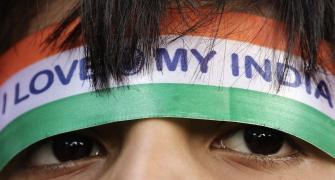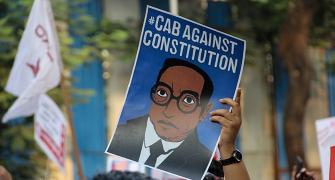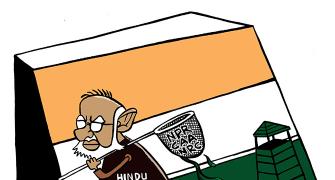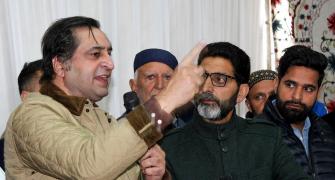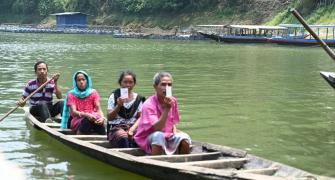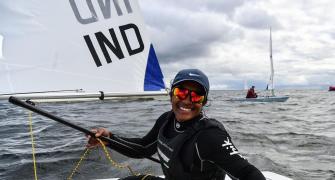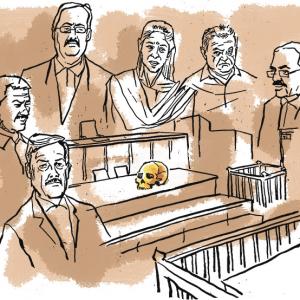In just 18 frames, the photograph of the dainty Sheena, with her winsome smile and starry eyes, dissolved, flesh falling off her facial bones, into what the CBI alleged was her corresponding yellowed, morose-looking skull with hollow, haunting eye sockets.
Vaihayasi Pande Daniel reports from the Sheena Bora murder trial.
Illustration: Dominic Xavier/Rediff.com
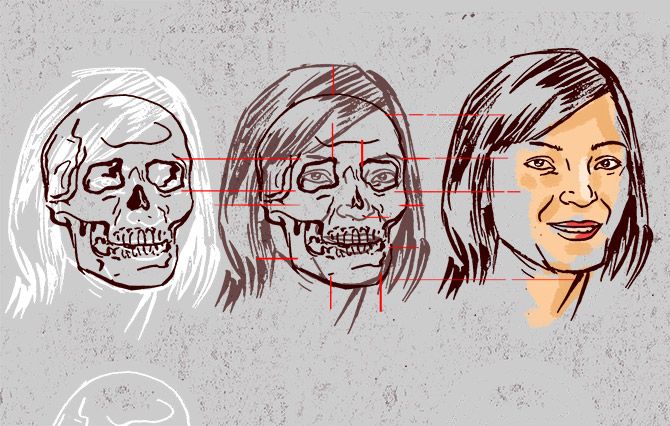
Dr Sunil Kumar Tripathi, 72, became, on Friday, January 3, Prosecution Witness No 60 and the first witness of 2020 in the Sheena Bora murder trial unfolding, since 2017, at Courtroom 51, Mumbai city civil and sessions, located in south Mumbai.
On Friday both Winter and the Brand New Year came merrily waltzing into this court, unasked.
Fans were off in No 51. Windows were open just a crack.
Accused No 4 former CEO Star India and INX Media, Peter Mukerjea was wearing a slightly rumpled charcoal jacket to combat Mumbai's unusual even if fractional drop in mercury.
And 2020 showed up, unexpectedly, poking its lively head too soon, into these dull courtrooms, like a politician offering difficult-to-believe promises of new beginnings and hope.
Dr Tripathi, who hailed from Varanasi and had been the head of the department of forensic medicine at IMS, Benares Hindu University, till his retirement in 2018, had been called to the witness box as an expert by the prosecution led by the usually taciturn, mild-mannered Special Public Prosecutor Manoj Chaladan.
This forensic man had conducted, in 2015, skull-photo superimposition tests using four pictures of Sheena and photographs, he took, of the skull found at Raigad district, Maharashtra.
Skull-photo superimposition tests use computer software to map, one by one, the similarities of various facial landmarks between a photograph of a dead person and his/her skull. The more the points of correspondence the better the result.
Through a series of frames, and hi-tech computer wizardry, the photograph can be shown to perfectly match the skull.
That is: In just 18 frames, the photograph of the dainty Sheena, with her winsome smile and starry eyes, dissolved, flesh falling off her facial bones, into what the CBI alleged was her corresponding yellowed, morose-looking skull with hollow, haunting eye sockets.
The aim of these tests was to, once again, attempt to prove that the skull found at rural Gagode Khurd, Raigad, in 2015 matched Sheena's photographs (although it was not specified if this was the skull unearthed in 2015 as opposed to the remains found in the same spot in 2012).
Dr Tripathi had been invited by the CBI to Delhi in November 2015 to meet doctors Sudhir Gupta and Adarsh Kumar of the forensic department at AIIMS, who were examining the skull sent to them from Mumbai. He was asked to run his own superimposition tests.
Over a period of two days he produced results for the four photographs.
The doctor, a moustachioed and bespectacled silver-haired man, attired in a pink shirt, a black vest and brown trousers, was an enthusiastic advocate of the skull-photo superimposition method.
In his testimony to the court, in the manner of a proselytizer, he eagerly explained what he felt was the veracity of the method and how it achieved its results.
The court was presented four sheets with strips of photographs of how the skull could magically metamorphose into Sheena once again, although the software used was a trial version (and had not even been purchased for the purpose of this case, leading to one of the accused to mutter semi-jokingly something to the effect that "they want to hang us on the basis of material for which they could not spend 25 dollars to purchase the actual software").
Dr Tripathi had learned this technique after he had attended a solitary workshop on facial reconstruction in 2004 conducted by "an international expert of repute in this field" Mehmet Yasar Iscan at Punjabi University at Patiala.
Iscan, a forensic anthropologist at Istanbul University's Institute of Forensic Sciences, specialised in human facial image identification and has written books on reconstruction of life from a skeleton.
Since then, Dr Tripathi has been working in the field of craniofacial identification, has written some 80 papers on the subject in both Indian and international journals and appeared in five court cases, including the Sheena Bora trial, as an expert in skull-photo superimposition.
Dr Tripathi's language was often convoluted, tortuous and hard to fathom, especially since he consistently referred picturesquely to the photographs of Sheena, that he used for his process, as "live photographs" as if the victim were once again alive sitting in the courtroom amongst us.
He told the court: "I started my superimposition work by taking several digital photographs of skull from different angles with different facial profiles. Simultaneously, I (have) chosen four live photographs of Sheena Bora. These live photographs were (having) very specific characters -- having a smile face with visible teeth."
"These photographs and digital skull photographs were processed as per the need of the software and superimposition made."
"Finally, when all characteristics (which) belongs to the face of Sheena Bora and the provided skull, match each other. Then I consider the visible smiling face, teeth and the skull's front teeth to match the various variables, for example, shape, size, tooth direction, gap between two teeths etc."
"Those variables also found to match each other, having all similar characteristics. Thus, I concluded that, all four sets of live photographs and the provided skull of digital photographs belongs to each other..."
"Therefore complete individual identification was made -- of the photographs of Sheena Bora and the provided skull, that belongs to the same individual."
His evidence, as he rattled it off in court, led to three questions that began to tickle oneS brain, namely -- Would not Dr Tripathi have also wanted to use Sheena's dental records for this process too, or maybe she had none?
And how was he, no professional photographer, able to take photographs of the skull at such a perfect angle that they matched the photographs chosen of Sheena?
And lastly didn't the skull, in the pictures being shown, have a far broader jaw than Sheena -- she was clearly not square-jawed?
After producing the sheets of superimposition photographs, Dr Tripathi had written up his report in 2015 that stated the photographs of Sheena matched the skull. He identified that report in court.
The court then broke for lunch.
Indrani Mukerjea, her long hair open and swathed in a watermelon pink kurta, with gold stripes and gold edging, made a pretty picture in court on Friday as she celebrated her birthday nibbling on a Cadbury Dairy Milk bar and giving off electric smiles.
"Isn't she very friendly?" asked a young newcomer to court, in a horrified whisper, her startled eyes finding it difficult to contain her shock at coming face to face with a smiling, cheerful, alleged murderer.
"How should Indrani be behaving?" I asked.
"Guilty. Like she had committed a murder."
That, when it was pointed out, Indrani was accused but not yet convicted and a human being like anyone else, with days of good moods and bad moods, was not easy to comprehend for this newcomer, as she continued to observe Indrani, fascinated, through the rest of the proceedings.
After the lunch recess, Dr Tripathi, on a laptop provided by Chaladan, engagingly demonstrated from a CD to a mildly curious CBI Special Judge Jayendra Chandrasen Jagdale, a posse of black-coated defence lawyers and the court how the software worked.
He showed how he chose certain hallmarks of the face like the nasal bone or the cheek and point by point mapped them and matched them with the skull.
Looking at the laptop screen, quite enamoured with the software, he took off pointing to Sheena's picture: "See this lip has lipstick, red colour lipstick..." and then pointing to the skull, "See here how just alike, can see how gradually the facial reconstruction is taking place..."
In conclusion, he declared: "Various facial landmarks and their corresponding landmarks over skull (are) considered along with application of forensic odontology, considering various characteristics of teeth which never be found of one individual to other individual (ie are unique to an individual). This give hundred percent accuracy."
But accuracy of facial reconstruction is debatable as evidenced by the slew of research papers all over the internet arguing its reliability. Most call it a helpful tool and not expert evidence.
Indeed in US courts, for instance, the Daubert Standard, which governs what is admissible as evidence legally, forensic facial reconstruction is 'not considered legally recognised technique for positive identification, and is not admissible as expert testimony'.*
The reason for this is: 'When multiple forensic artists produce approximations for the same set of skeletal remains, no two reconstructions are ever the same and the data from which approximations are created are largely incomplete'.** That is, results from different forensic construction experts tend to differ.
There are also a variety of morphing programmes on the Internet, less scientific than the ones that forensic experts utilise, that use software gimmickry to morph two totally disparate photographs together to appear like one naturally emerged from the other. Were the techniques that different, one wondered?
Indrani's lawyer Gunjan Mangla began Dr Tripathi's cross-examination. Her first question related to the CD the forensic doctor had used to demonstrate his technique in court. She wanted to know when it had been burned.
Dr Tripathi admitted that he had burned three CDs the night before from data he had on a pen drive in his possession.
It was not clear why the pen drive had not been submitted as evidence along with the sheets of superimposition photographs in 2015.
There was a bit of an argument about when the forensic expert's cross examination would continue.
Dr Tripathi said he was 72 and a prostate cancer survivor and found it difficult to spend too much time in the witness box without bathroom breaks, "har do ghanta urine jaana hai." Nor did he want to be gone from home too long.
He added, speaking to the defence: "Nobody knows how much you will ask!"
Judge Jagdale concurred: "Don't torture. This is not a torture chamber."
A little discussion broke out about the joys of Varanasi.
The judge mused that Dr Tripathi was here from Varanasi while all people were headed to Varanasi "ghumne ke liye (for sightseeing). Sab old-age walle (all old people)."
Chaladan chimed in, disagreeing: "No sir, last month I myself was there."
It was decided the cross examination would continue on Tuesday January 7.
Indrani, who submitted her fifth bail application, on merit, late last month before the courts closed for the holidays, exchanged harsh words with ex-husband Peter after he, she said, made a rude remark to her while she was in the accused dock.
"He can't abuse me like this," she remarked, hurt, to her lawyer and refused to accept the apology Peter came to tender.
After the accused left and before the hearing closed, lawyers for Peter and Indrani, Mangla and Viral Babar, approached the judge requesting permission to prevent interactions between their clients, after this altercation.
The judge nodded sagaciously and agreed, adding, a smile alternately lurking under his bushy moustache: "They don't need to interact with each other when they are represented by powerful lawyers like you both!"
*Hard Evidence: Case Studies in Forensic Anthropology by Dawnie Wolfe Steadman, professor and director, Forensic Anthropology Center, Tennessee
**Assessment of the Reliability of Facial Reconstruction by R Helmer, et al.
Vaihayasi Pande Daniel covers the Sheena Bora Murder Trial for Rediff.com.
You can read her fascinating coverage here.

